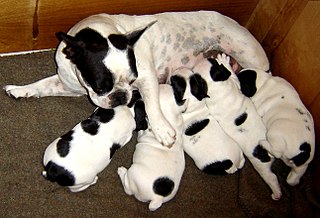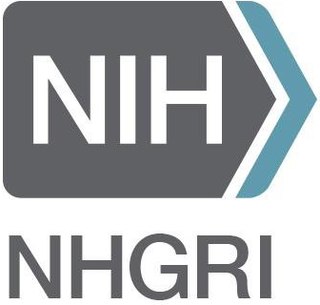
The Basenji is a breed of hunting dog. It was bred from stock that originated in central Africa. The Fédération Cynologique Internationale places the breed in the Spitz and primitive types. The Basenji produces an unusual yodel-like sound, due to its unusually shaped larynx. This trait also gives the Basenji the nickname the 'barkless dog.'

A dog breed is a particular type of dog that was purposefully bred by humans to perform specific tasks, such as herding, hunting, and guarding. Dogs are the most variable mammal on Earth, with artificial selection producing upward of 360 globally recognized breeds. These breeds possess distinct traits related to morphology, which include body size, skull shape, tail phenotype, fur type, body shape, and coat colour. However, there is only one species of dog. Their behavioral traits include guarding, herding, and hunting, and personality traits such as hyper-social behavior, boldness, and aggression. Most breeds were derived from small numbers of founders within the last 200 years. As a result, today dogs are the most abundant carnivore species and are dispersed around the world.

Dog breeding is the practice of mating selected dogs with the intention of maintaining or producing specific qualities and characteristics. When dogs reproduce without such human intervention, their offspring's characteristics are determined by natural selection, while "dog breeding" refers specifically to the artificial selection of dogs, in which dogs are intentionally bred by their owners. Breeding relies on the science of genetics, hence a breeder who is knowledgeable on canine genetics, health, and the intended purpose of the dogs attempts to breed suitable dogs.

The National Human Genome Research Institute (NHGRI) is an institute of the National Institutes of Health, located in Bethesda, Maryland.

The dog is a domesticated descendant of the wolf. Also called the domestic dog, it is derived from extinct Pleistocene wolves, and the modern wolf is the dog's nearest living relative. The dog was the first species to be domesticated by humans. Hunter-gatherers did this, over 15,000 years ago in Germany, which was before the development of agriculture. Due to their long association with humans, dogs have expanded to a large number of domestic individuals and gained the ability to thrive on a starch-rich diet that would be inadequate for other canids.
Any cause that reduces or increases reproductive success in a portion of a population potentially exerts evolutionary pressure, selective pressure or selection pressure, driving natural selection. It is a quantitative description of the amount of change occurring in processes investigated by evolutionary biology, but the formal concept is often extended to other areas of research.

Francis Sellers Collins is an American physician-geneticist who discovered the genes associated with a number of diseases and led the Human Genome Project. He served as director of the National Institutes of Health (NIH) in Bethesda, Maryland, from 17 August 2009 to 19 December 2021, serving under three presidents.

Alan Edward Guttmacher is an American physician who was the director of the National Institute of Child Health (NICHD), one of the 27 institutes and centers that comprise the National Institutes of Health (NIH). In that capacity, he oversaw the institute’s activities as the focal point at the NIH for research in pediatric health and development, maternal health, reproductive health, intellectual and developmental disabilities, and rehabilitation medicine, among other areas.

Eric D. Green is an American genomics researcher who had significant involvement in the Human Genome Project. He is the director of the National Human Genome Research Institute (NHGRI) at the National Institutes of Health (NIH), a position he has held since 2009.

The Cane Paratore is a breed of herding dog from Italy. The breed primarily exists in its traditional role in Abruzzo, its historical region of origin, having not gained popularity from outside dog fanciers.

The horse genome was first sequenced in 2006. The Horse Genome Project mapped 2.7 billion DNA base pairs, and released the full map in 2009. The horse genome is larger than the dog genome, but smaller than the human genome or the bovine genome. It encompasses 31 pairs of autosomes and one sex chromosome pair.
Clinicogenomics, also referred to as clinical genomics, is the study of clinical outcomes with genomic data. Genomic factors have a causal effect on clinical data. Clinicogenomics uses the entire genome of a patient in order to diagnose diseases or adjust medications exclusively for that patient. Whole genome testing can detect more mutations and structural anomalies than targeted gene testing. Furthermore, targeted gene testing can only test for the diseases for which the doctor screens, whereas testing the whole genome screens for all diseases with known markers at once.

Charles Nohuoma Rotimi is the Scientific Director of the National Human Genome Research Institute (NHGRI). He joined the National Institutes of Health (NIH) in 2008 as the inaugural Director of the Trans-NIH Center for Research in Genomics and Global Health and was also the chief of the NHGRI's Metabolic, Cardiovascular, and Inflammatory Disease Genomics Branch. He works to ensure that population genetics include genomes from African populations and founded the African Society of Human Genetics in 2003 and was elected its first president. Rotimi was instrumental in the launch of the Human Heredity and Health in Africa (H3Africa) with the NIH and the Wellcome Trust. He was elected to the National Academy of Medicine in 2018.

Joan Ellen Bailey-Wilson is an American statistical geneticist. She is a senior investigator and co-chief of the Computational and Statistical Genomic Branch of the National Human Genome Research Institute.
Susan E. Celniker is an American biologist, a staff scientist at Lawrence Berkeley National Laboratory and an adjunct professor Comparative Biochemistry department at UC Berkeley. She is the co-director of the Berkeley Drosophila Genome Project.
Charmaine DM Royal is an American geneticist and Associate Professor at the Institute for Genome Sciences & Policy and the Department of African and African American Studies at Duke University. She studies the intersections of race, ethnicity, ancestry genetics, and health, especially as they pertain to historically marginalized and underrepresented groups in genetic and genomic research; and genomics and global health. Her major interest is in addressing root causes and implementing sustainable solutions regarding problems of race and racism in research, healthcare, and society. Royal is a Human Heredity and Health in Africa (H3Africa) Independent Expert Committee (IEC) member appointed by the National Institutes of Health (NIH) and is a 2020 Ida Cordelia Beam Distinguished Visiting Professor at the University of Iowa.

Vence L. Bonham Jr. is an American lawyer who is the acting Deputy Director of the National Human Genome Research Institute (NHGRI) of the U. S. National Institutes of Health, and is the leader of the NHGRI Health Disparities Unit. His research focuses on social determinants of health, particularly with regard to the social implications of new genomic knowledge and technologies.

Kathy Lynn Hudson is an American microbiologist specializing in science policy. She was the deputy director for science, outreach, and policy at the National Institutes of Health from October 2010 to January 2017. Hudson assisted in the creation and launch of All of Us, the BRAIN initiative, and the National Center for Advancing Translational Sciences. She founded the Genetics and Public Policy Center at Johns Hopkins University in 2002. Hudson is an advocate for women in science.

Tara Matise is an American geneticist at Rutgers University. Since 2018, she has served as chair of the Department of Genetics. Her research interests span computational genetics, data science, and human genetics. She is co-director of the Rutgers University Genetics Coordinating Center.
















